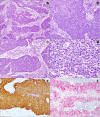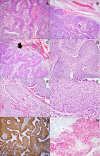HPV-Associated Squamous Cell Carcinoma of the Eyelid: Diagnostic Utility of p16 Immunohistochemistry and mRNA In Situ Hybridization
- PMID: 37735287
- PMCID: PMC10739694
- DOI: 10.1007/s12105-023-01582-6
HPV-Associated Squamous Cell Carcinoma of the Eyelid: Diagnostic Utility of p16 Immunohistochemistry and mRNA In Situ Hybridization
Abstract
Background: High-risk (HR) Human papillomavirus (HPV) has been implicated in pathogenesis of squamous cell carcinomas (SCC) at several sites with mucocutaneous junctions, including the head and neck. SCC is the second most common eyelid malignancy. However, its association with transcriptionally active HR-HPV has not been adequately studied.
Methods: Two index cases of eyelid HPV-associated SCC are described in detail. A retrospective cohort of eyelid SCC was examined for p16 immunoexpression. Cases demonstrating p16 positivity or equivocal staining were subjected to high-risk HPV mRNA in situ hybridization (ISH). Quantitative real-time PCR (qPCR) was performed in mRNA ISH-positive cases for HPV genotyping.
Results: The two index patients were older adult females, with upper eyelid tumours. On histology, both tumours were non-keratinizing SCC with trabecular and nested architecture reminiscent of oropharyngeal HPV-associated non-keratinizing SCC, prompting p16 immunohistochemistry, which was positive. HR-HPV mRNA ISH was positive, and qPCR detected HPV16 in both cases. Three of 20 (15%) archival cases showed p16 immunopositivity and two (10%) showed equivocal staining. However, mRNA ISH was negative. All cases showing p16 immunostaining and lacking HR-HPV were keratinizing SCCs. Thus, 9% of all eyelid SCC examined demonstrated HR-HPV.
Conclusion: The prevalence of HR-HPV in eyelid SCC is low in Indian patients. HPV-associated SCC may mimic commoner eyelid carcinomas as it lacks overt keratinization. In basaloid-appearing eyelid carcinomas, p16 immunopositivity should be followed by reflex HR-HPV mRNA ISH, as p16 immunohistochemistry alone has low specificity. The prognostic role, if any, of HPV association needs further evaluation.
Keywords: Eyelid carcinoma; Human papillomavirus; Immunohistochemistry; Non-keratinizing squamous cell carcinoma; mRNA in situ hybridization.
© 2023. The Author(s), under exclusive licence to Springer Science+Business Media, LLC, part of Springer Nature.
Conflict of interest statement
The authors declare no competing interests.
Figures


Similar articles
-
Evaluation of high-risk human papillomavirus in sinonasal papillomas and squamous cell carcinomas.Virchows Arch. 2023 Sep;483(3):381-392. doi: 10.1007/s00428-023-03601-x. Epub 2023 Jul 15. Virchows Arch. 2023. PMID: 37452847
-
Strong SOX10 expression in human papillomavirus-related multiphenotypic sinonasal carcinoma: report of 6 new cases validated by high-risk human papillomavirus mRNA in situ hybridization test.Hum Pathol. 2018 Dec;82:264-272. doi: 10.1016/j.humpath.2018.07.026. Epub 2018 Jul 31. Hum Pathol. 2018. PMID: 30071233
-
The utility of high-risk human papillomavirus E6/E7 mRNA in situ hybridization in assessing HPV status on cell block.J Am Soc Cytopathol. 2021 Mar-Apr;10(2):225-230. doi: 10.1016/j.jasc.2020.09.007. Epub 2020 Sep 30. J Am Soc Cytopathol. 2021. PMID: 33092993
-
HPV-related squamous cell carcinoma of the head and neck: An update on testing in routine pathology practice.Semin Diagn Pathol. 2015 Sep;32(5):344-51. doi: 10.1053/j.semdp.2015.02.013. Epub 2015 Feb 4. Semin Diagn Pathol. 2015. PMID: 25724476 Review.
-
Current Status of p16 Immunohistochemistry and HPV Testing in Fine Needle Aspiration Specimens of the Head and Neck.Acta Cytol. 2020;64(1-2):30-39. doi: 10.1159/000496158. Epub 2019 Feb 15. Acta Cytol. 2020. PMID: 30783052 Review.
Cited by
-
EGFR mutations in sinonasal squamous neoplasms: Novel hotspot for exon 20 insertions.Virchows Arch. 2025 Mar 13. doi: 10.1007/s00428-025-04070-0. Online ahead of print. Virchows Arch. 2025. PMID: 40080145
References
-
- Munoz N, Castellsague X, de Gonzalez AB, Gissmann L. Chapter 1: HPV in the etiology of human cancer. In: Bosch FX, Cuzick J, Schiller JT, Garnett GP, Meheus A, Franco EL, Wright TC, editors. Vaccine. Amsterdam: Elsevier; 2006. - PubMed
-
- McDonnell JM, McDonnell PJ, Sun YY. Human papillomavirus DNA in tissues and ocular surface swabs of patients with conjunctival epithelial neoplasia. Invest Ophthalmol Vis Sci. 1992;33:184–189. - PubMed
-
- Detorakis ET, Drakonaki EE, Spandidos DA. Molecular genetic alterations and viral presence in ophthalmic pterygium. Int J Mol Med. 2000;6:35–41. - PubMed
MeSH terms
Substances
LinkOut - more resources
Full Text Sources
Research Materials

